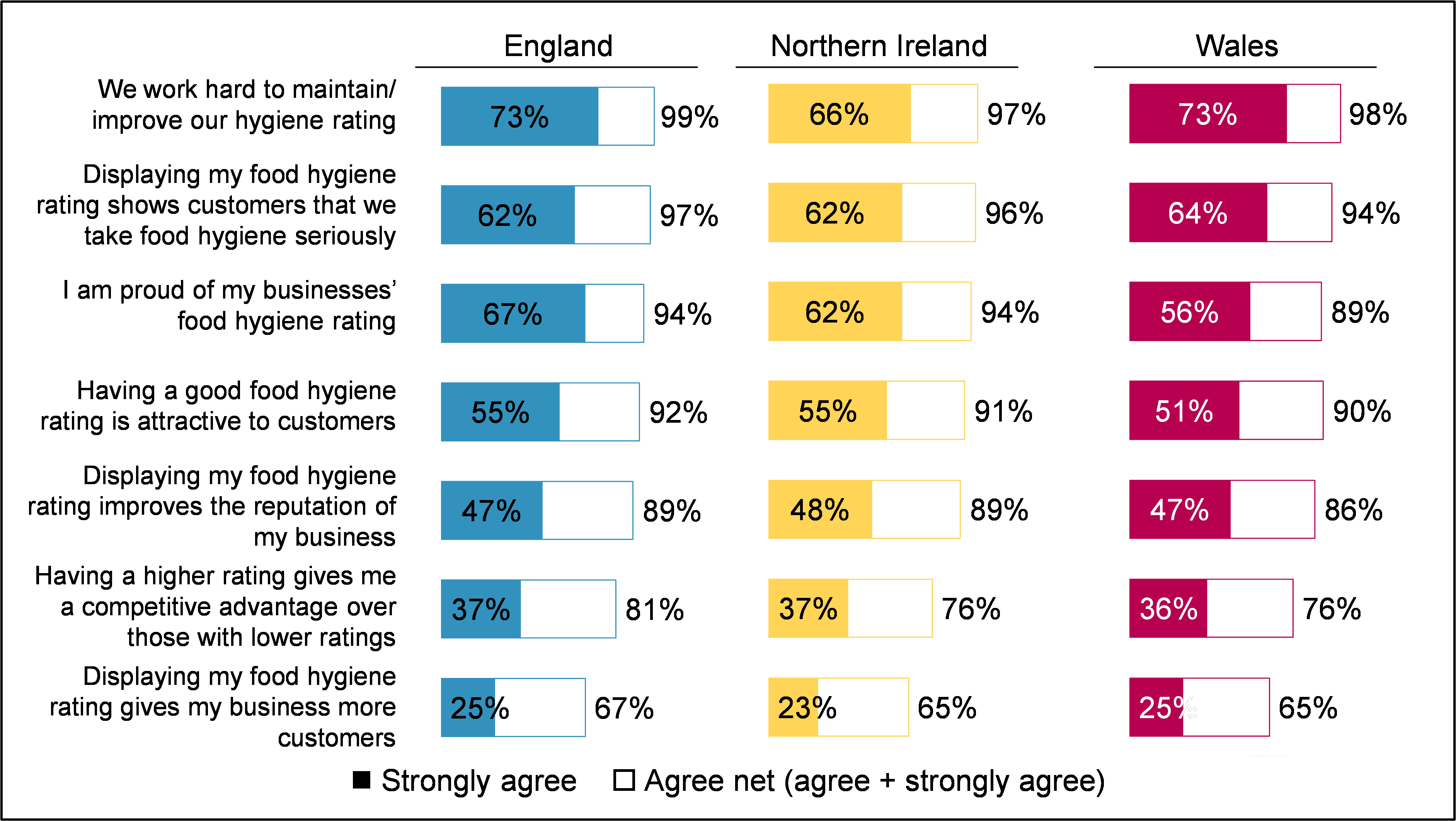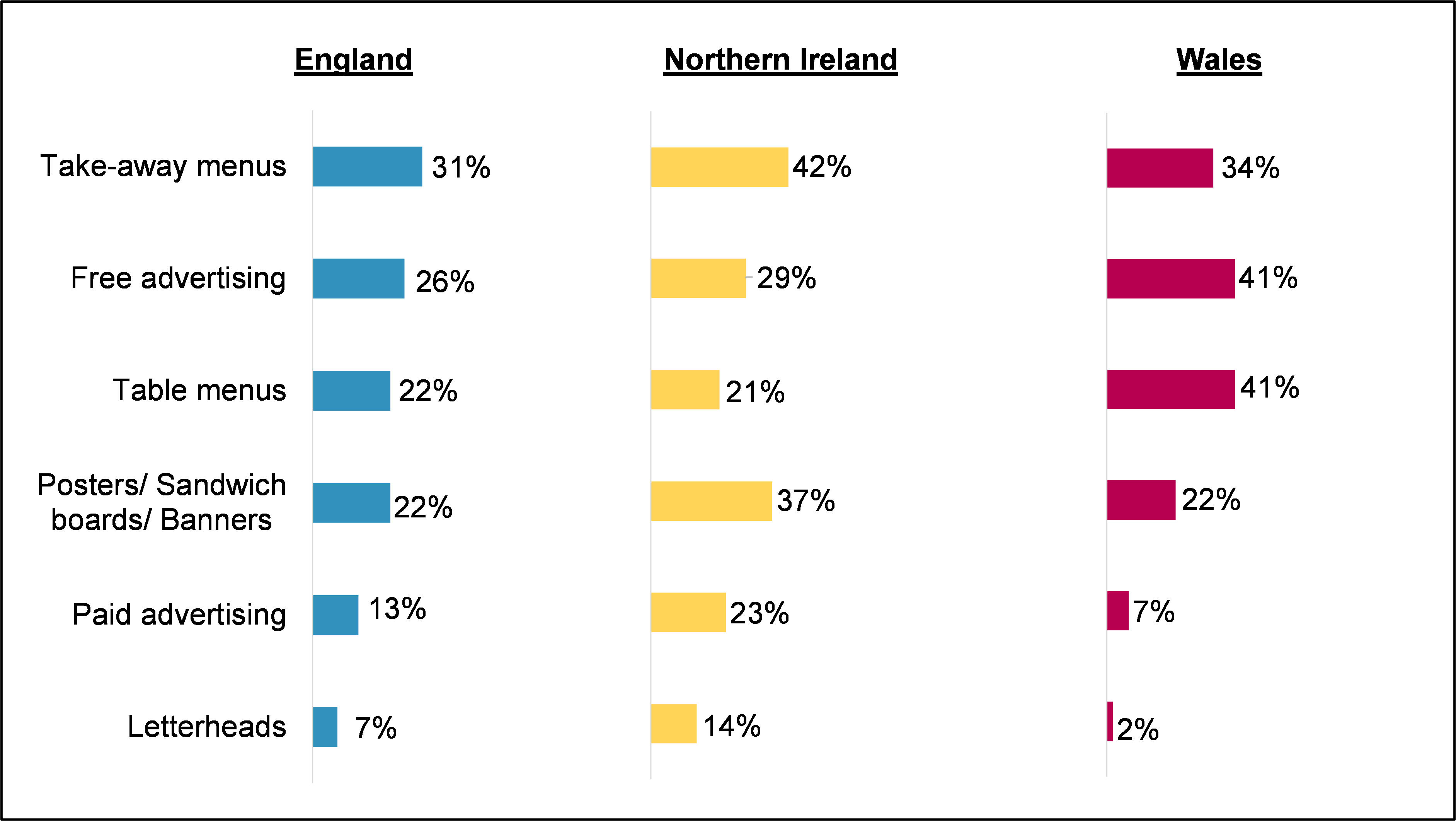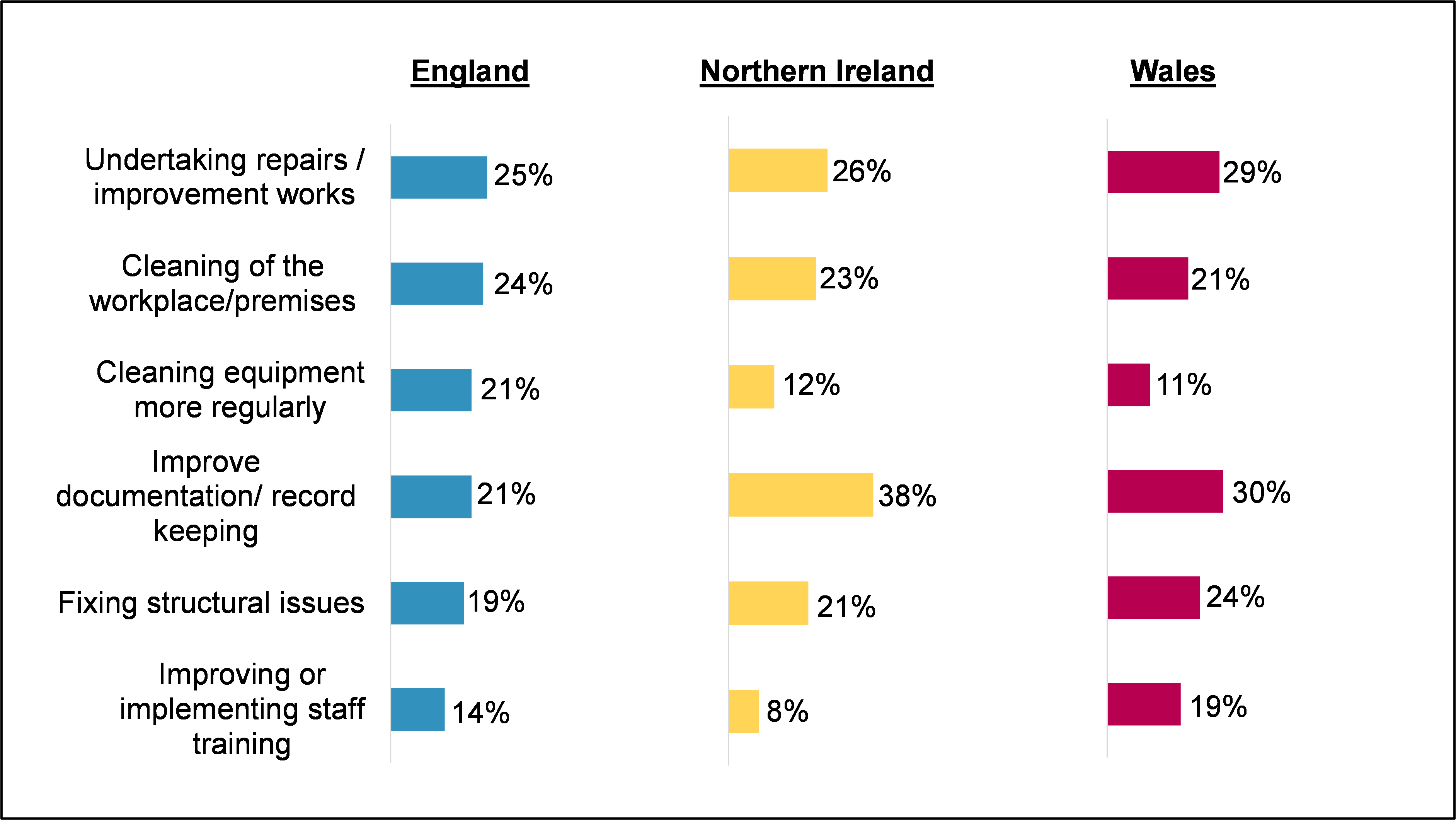FHRS Display Audit 2022 - Impacts of the scheme
This chapter covers how food businesses displaying a food hygiene rating feel about the Food Hygiene Rating Scheme (FHRS).
Specifically, it looks at changes made by businesses with a food hygiene rating of less than 5 in order to improve their rating at the next inspection and what kind of impact they feel the scheme has on their business and potential customers. It also explores actual and potential use of food hygiene ratings in promotion and advertising.
Business and customer perceptions of food hygiene ratings
Overall, most businesses reported being incentivised to maintain or improve their food hygiene rating and consider that the display of their rating has a range of positive impacts on customer perceptions of the business.
As presented in Figure 8.1, nearly all businesses in England, Northern Ireland and Wales agreed that they worked hard to maintain or improve their food hygiene rating (England 99%; Northern Ireland 97%; Wales 98%) and that displaying a food hygiene rating proved to consumers that the business takes food hygiene seriously (England 97%; Northern Ireland 96%; Wales 94%).
Figure 8.1 Perceptions of FHRS

England: We work hard to maintain/improve our hygiene rating (Agree 73%, Strongly Agree 99%), Displaying my food hygiene rating shows customers that we take food hygiene seriously (Agree 62%, Strongly Agree 97%), I am proud of my businesses' food hygiene rating (Agree 67%, Strongly Agree 94%), Having a good food hygiene rating is attractive to customers (Agree 55%, Strongly Agree 92%), Displaying my food hygiene rating improves the reputation of my business (Agree 47%, Strongly Agree 89%), Having a higher rating gives me a competitive advantage over these with lower ratings (Agree 37%, Strongly Agree 81%), Displaying my food hygiene rating gives my business more customers (Agree 25%, Strongly Agree 67%). Northern Ireland: We work hard to maintain/improve our hygiene rating (Agree 66%, Strongly Agree 97%), Displaying my food hygiene rating shows customers that we take food hygiene seriously (Agree 62%, Strongly Agree 96%), I am proud of my businesses' food hygiene rating (Agree 62%, Strongly Agree 94%), Having a good food hygiene rating is attractive to customers (Agree 55%, Strongly Agree 91%), Displaying my food hygiene rating improves the reputation of my business (Agree 48%, Strongly Agree 89%), Having a higher rating gives me a competitive advantage over these with lower ratings (Agree 37%, Strongly Agree 76%), Displaying my food hygiene rating gives my business more customers (Agree 23%, Strongly Agree 65%). Wales: We work hard to maintain/improve our hygiene rating (Agree 73%, Strongly Agree 98%), Displaying my food hygiene rating shows customers that we take food hygiene seriously (Agree 64%, Strongly Agree 94%), I am proud of my businesses' food hygiene rating (Agree 56%, Strongly Agree 89%), Having a good food hygiene rating is attractive to customers (Agree 51%, Strongly Agree 90%), Displaying my food hygiene rating improves the reputation of my business (Agree 47%, Strongly Agree 86%), Having a higher rating gives me a competitive advantage over these with lower ratings (Agree 36%, Strongly Agree 76%), Displaying my food hygiene rating gives my business more customers (Agree 25%, Strongly Agree 65%).
B23. To what extent do you agree or disagree with the following statements about the Food Hygiene Rating scheme....? Base: FBOs with FHRS on display: England (407); Northern Ireland (477) Wales (467).
Furthermore, almost as many businesses stated that they were proud of their food hygiene rating (England 94%; Northern Ireland 94%; Wales 89%). Perhaps unsurprisingly, across all countries, those with a rating of 5 were more likely to be proud (England 98%; Northern Ireland 97%; Wales 96%). There were also differences by outlet type within both Northern Ireland and Wales. In Northern Ireland, restaurants and catering businesses were more likely to be proud of their rating (97%), while in Wales, accommodation and pubs, bars and nightclubs were less likely to be (83%).
Agreement was notably lower with regards to the impact the scheme has on levels of custom. There was widespread agreement that good food hygiene ratings were attractive to customers (England: 92%; Northern Ireland: 91%; Wales: 90%) and around two-thirds agreed that displaying a food hygiene rating resulted in more customers (England: 67%; Northern Ireland: 65%; Wales: 65%).
There was a similar ranking of different impacts seen in 2021.
Use of food hygiene ratings for promotion
Across each nation, less than one in five food businesses said they used their food hygiene rating to promote their business, for example through display in advertising or on menus (England: 14%; Northern Ireland: 11%; Wales: 9%).
In England, takeaways and sandwich shops stood out as more likely to use food hygiene ratings in promotional materials (27%), while retail businesses were less likely to (4%). Furthermore, English food businesses with a rating of 5 were more likely to use their rating in advertisements in England (16%). There were no significant differences by outlet type or rating in Northern Ireland or Wales.
Figure 8.2 presents the channels used by food businesses that use their food hygiene rating to advertise. The mix of channels used differed quite widely by country. In England and Northern Ireland, it was most common to advertise through take-away menus (England 31%; Northern Ireland 42%), while in Wales, free advertising and table menus were the more common channels (each used by 41% of businesses). The way this question was asked changed between 2021 and 2022, to separate out online and general forms of advertising, so comparisons over time are not possible.
Figure 8.2 Forms the Food Hygiene Rating is used for advertisement by country

B18. Does your business currently use its Food Hygiene Rating in any of the following forms of advertisement? Base: FBOs who use their FHRS to advertise: England (58); Northern Ireland (51) Wales (44).
Changes made as a result of FHRS
Across all three nations, most food businesses that had received a food hygiene rating of 4 or less reported making changes to try to improve their rating (England: 83%; Northern Ireland: 85%; Wales: 82%)
As presented in Figure 8.3, the most common actions differed by country. In England, the most common action was undertaking repairs or improvements (25%), closely followed by cleaning the workplace or premises (24%). Whereas in Northern Ireland and Wales, the most common action was improving documentation or record keeping (Northern Ireland 38%; Wales 30%).
Figure 8.3 Changes made to improve food hygiene ratings

B9. What changes have you made at your premises in order to achieve a higher Food Hygiene Rating at your next inspection? Base: FBOs with a rating of less than 5 and made changes to improve their rating: England (89); Northern Ireland (75) Wales (133).
Some differences can be seen over time in the changes which businesses made to improve their food hygiene rating. There was an increase in the proportion of businesses citing improved documentation or record keeping in Northern Ireland (38%, up from 18% in 2021 and 17% in 2019).
Revision log
Published: 29 June 2023
Last updated: 5 July 2024